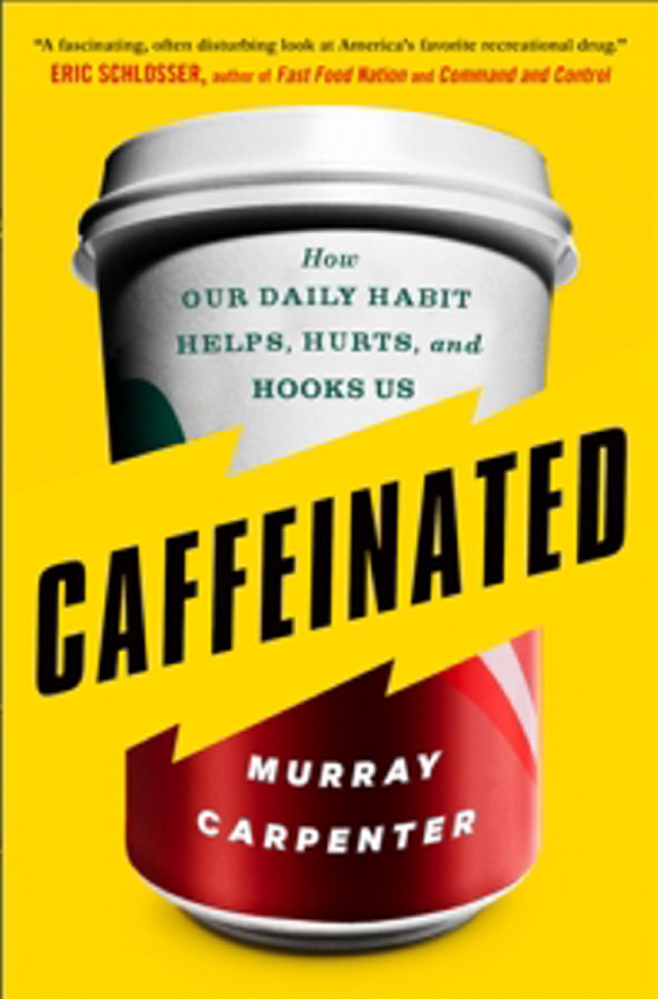“Caffeinated: How Our Daily Habit Helps, Hurts and Hooks Us”
By Murray Carpenter
Plume Books, 2015
288 pages, trade paperback, $16.
Recently I became, as one of my correspondents put it, “the very last person” to read Stieg Larsson’s “Girl With the Dragon Tattoo” books, and one of the quirky things in them is that on practically every page, somebody is making coffee. No wonder there’s a 6-foot-6 superhuman psychopath who cannot feel pain. He’s been living in Sweden where, as Murray Carpenter’s fascinating book “Caffeinated” relates, the average Swede drinks 1,460 cups of coffee a year.
Most Americans don’t drink that much coffee, it turns out. It only seems like it. But however you get your caffeine — and most humans get it somehow, whether from coffee, tea, Coke, Mountain Dew, Red Bull, chocolate, gum, guarana, energy gel — Carpenter explains it and all its cultural and economic angles. He traveled from his home in Belfast to cacao farms in Mexico, coffee plantations in Colombia, tea shops in Beijing, the World Coffee Conference in Guatemala, the offices of food and drug experts in the U.S., to dig out every last bit of information he could about the drug that gives practically everybody’s body — and mind — a charge.
Caffeine, as everyone knows, is the kick in your coffee, which is the delivery mechanism most Americans prefer to get the drug. Coffee consumption in the U.S. actually peaked during the 1940s at an average of 46 gallons per person per year (which is 736 cups, well behind the Swedes). In the 1950s, other caffeine-content drinks, like soda, challenged coffee’s dominance and expanded with clever marketing. These products are all so familiar that most of us probably just assume that the common ingredient they deliver, caffeine, while providing a certain innocuous buzz, is perfectly safe.
But it’s not. “A sixty-fourth of a teaspoon, the amount in many soft drinks,” Carpenter tells us, “will give you a subtle boost. A sixteenth of a teaspoon, about the amount in twelve ounces of coffee, is a good solid dose for a habituated user. A quarter teaspoon will lead to bodily unpleasantness — racing heart, sweating and acute anxiety. A tablespoon will kill you.”
Carpenter says he bought online, perfectly legally, a 100-gram packet of pure crystallized caffeine — enough for 10 lethal doses. Energy drinks in recent decades have pushed the concentration beyond what we’ve normally gotten in coffee, tea and soda, and as a result abusers are getting poisoned by, and sometimes dying of, caffeine-related overdoses. Battles involving soft drink makers, the FDA and watchdog scientists have been going on for decades about whether or how this widely used drug should be regulated. Carpenter details all sides of the issue.
The dangers, benefits and curiosities of one of the most widely used drugs in human history are meticulously described in this accomplished midcoast writer’s lucid, matter-of-fact, often wry firsthand account. Murray Carpenter’s reporting has appeared in The New York Times, Down East Magazine and National Geographic, among others, as well as on Maine and national public radio.
“Caffeinated” will open your eyes even wider than your morning coffee. Unless you’re from Sweden. The paperback edition released in January is available from bookstores and online booksellers. More information on Carpenter’s work is at murraycarpenter.com.
Off Radar takes note of books with Maine connections about twice a month in the Kennebec Journal and Morning Sentinel’s What’s Happening? Contact Dana Wilde at universe@dwildepress.net.
Copy the Story LinkSend questions/comments to the editors.



Success. Please wait for the page to reload. If the page does not reload within 5 seconds, please refresh the page.
Enter your email and password to access comments.
Hi, to comment on stories you must . This profile is in addition to your subscription and website login.
Already have a commenting profile? .
Invalid username/password.
Please check your email to confirm and complete your registration.
Only subscribers are eligible to post comments. Please subscribe or login first for digital access. Here’s why.
Use the form below to reset your password. When you've submitted your account email, we will send an email with a reset code.